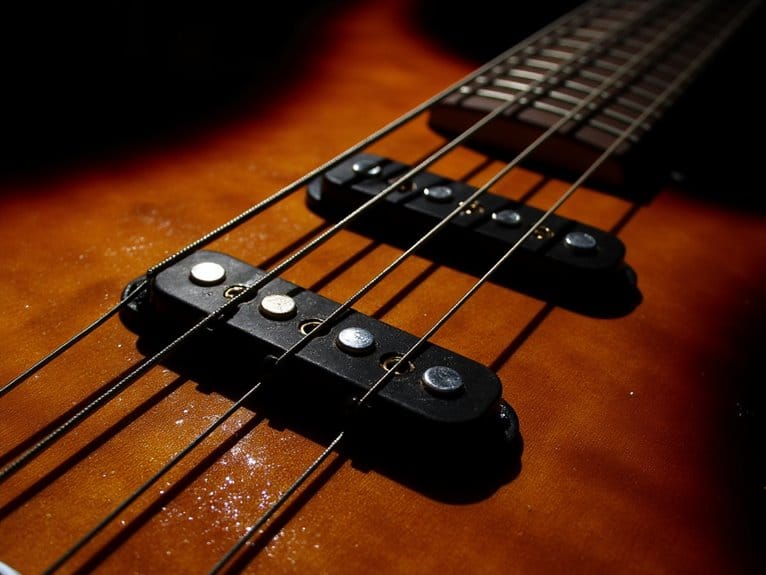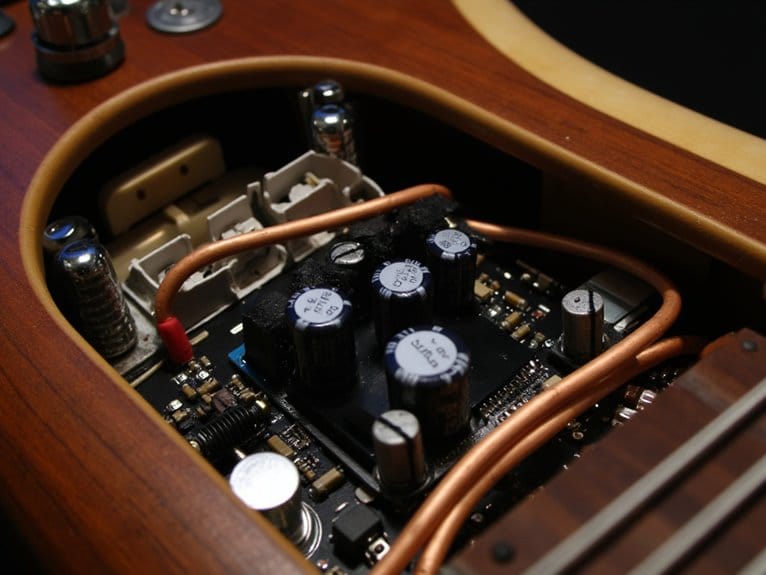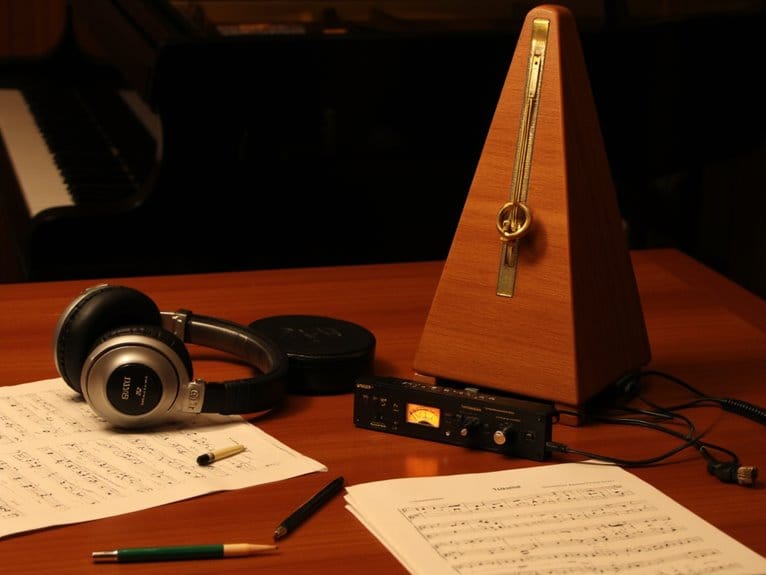Bass Guitar Pickup Placement and Its Effect on Tone
Your bass pickup’s position along the string dramatically alters your tone by capturing different harmonic content—neck placement delivers warm, full bass frequencies perfect for jazz and blues, while bridge position emphasizes bright harmonics and aggressive attack ideal for metal and punk. Single pickups offer tonal purity without frequency overlap, though multiple configurations provide genre versatility through separate volume controls, fundamentally acting as internal EQ that boosts or cuts specific frequencies before reaching your amp.
We are supported by our audience. When you purchase through links on our site, we may earn an affiliate commission, at no extra cost for you. Learn more.
Notable Insights
- Neck pickup placement emphasizes warm, full bass frequencies and low mids, making it ideal for jazz and blues styles.
- Bridge pickup positioning captures more harmonics and overtones, producing brighter sounds with enhanced treble for aggressive genres.
- Middle pickup placement provides balanced frequency distribution, offering versatile sound suitable for pop and session work across multiple genres.
- Pickup height adjustments can transform tone characteristics significantly, affecting both playability and sound quality when properly spaced from strings.
- Multiple pickup configurations allow increased tonal versatility through separate volume controls, though they may complicate wiring and potentially reduce sustain.
How Pickup Position Along the String Affects Your Bass Tone
When I first started playing bass, I’ll admit I didn’t give much thought to where pickups were positioned along the strings, but understanding this fundamental concept has transformed how I approach tone shaping.
Your pickup’s placement dramatically affects the harmonic content your instrument captures, with each position offering distinct sonic characteristics that’ll change your entire musical approach.
Near the neck, you’ll capture larger string vibrations that emphasize warm, full bass frequencies and low mids, perfect for jazz and blues where smooth tones matter most. The magnet type in your pickup also influences the warmth and attack characteristics, with different materials producing varying sonic responses.
Bridge positions grab more harmonics and overtones, creating brighter, sharper sounds with enhanced treble that cuts through rock mixes.
Middle placement gives you balanced frequency distribution, while each position’s unique tonal nuances affect how your bass sits within different musical contexts and playing styles. These placements align with the sweet spots that classic designers like Leo Fender discovered along the string’s rotation pattern.
The distance between your pickups and strings is crucial for maintaining proper playability without compromising your instrument’s sound quality. High-output pickups can particularly transform your tonal dynamics when properly positioned, especially in genres like rock and punk where aggressive sound characteristics are essential. Models with specific pickup configurations like the Dynamix P pickup demonstrate how placement affects the deep, punchy tones that make certain instruments stand out from others.
Single vs. Multiple Pickup Configurations: Finding Your Sweet Spot
Looking at my collection of basses over the years, I’ve learned that choosing between single and multiple pickup configurations isn’t just about having more options—it’s about finding the right balance between tonal versatility and focused simplicity that matches your playing style.
Single pickup basses offer tonal purity without frequency overlap complications, though single coils can introduce noise issues that humbucker advantages clearly address.
Multiple pickups provide genre versatility but increase wiring complexity and potential phase cancellation problems that’ll make your sound engineer cringe. Advanced electronic components in high-end basses allow for extensive tone customization that can help mitigate these issues while maintaining signal clarity.
I’ve noticed sustain issues with multi-pickup setups, where inactive magnetic fields reduce note length—sometimes by several seconds compared to single pickup configurations.
While PJ combinations excel at covering everything from jazz to metal, single pickup basses deliver consistent, focused tone that’s particularly valuable in live situations where simplicity trumps versatility. Adding a quality bass preamp can enhance your instrument’s natural character while providing additional tonal shaping capabilities for both single and multiple pickup configurations. Understanding pickup types becomes essential when evaluating the sonic character differences between single-coil and humbucker configurations. The choice of pickup placement significantly affects the fundamental character of your instrument, as positioning closer to the bridge yields brighter attack while neck positioning emphasizes warmer midrange frequencies.
Technical Factors That Shape Your Bass Sound Through Placement
While most bassists focus on pickup brands and output levels, the physical placement of these magnetic transducers creates far more dramatic tonal changes than swapping between different manufacturers’ models.
Your pickup height adjustment alone can transform a muddy, undefined tone into a punchy, articulate sound, though positioning them too close creates unwanted fret buzz and rattling.
The secret lies in understanding how string vibrations interact with harmonic nodes along your bass’s scale length, where each position captures different frequencies and amplitude variations. Much like how karaoke systems rely on frequency response ranges to accurately reproduce sound, pickup placement determines which tonal frequencies your bass naturally emphasizes.
Bridge placement emphasizes velocity-sensitive upper harmonics, delivering aggressive attack and note definition, while neck positioning captures greater string displacement for warmer, bass-heavy tones. The improved tuning precision from proper hardware setup, similar to how gear ratios enhance control in various musical environments, contributes to maintaining consistent pickup-to-string relationships during performance.
This placement effectively functions as built-in EQ, naturally boosting or cutting specific frequency ranges without external processing.
For bassists seeking additional tonal sculpting beyond pickup positioning, a bass preamp can provide comprehensive EQ control and signal enhancement to complement your instrument’s natural characteristics.
Matching Pickup Placement to Musical Genres and Playing Styles
Although pickup brands get most of the attention in bass forums, I’ve found that matching your pickup placement to your musical style creates far more dramatic tonal improvements than swapping expensive electronics.
Your pickup placement preferences should align directly with genre tonal characteristics, since bridge pickups deliver the aggressive attack that metal and punk demand, while neck positions provide the warm fundamentals essential for jazz and blues expression.
If you’re playing funk or slap styles, you’ll need that bright, percussive snap from bridge-mounted pickups, whereas fingerstyle techniques benefit from the smooth, round tones of neck placement. The nut width of your bass neck also impacts these fingerstyle techniques, with wider necks providing better string spacing for complex fingering patterns.
Pop and session work typically requires mid-scale positioning for balanced versatility, allowing you to cover multiple genres without constantly adjusting your setup. Modern musicians often incorporate dual-zone capabilities similar to professional drum triggers, using separate volume controls to access both aggressive and warm tonal ranges within the same performance.
For rock genres specifically, dual pickup configurations with separate volume and tone controls allow for precise sound customization to achieve both the aggressive tonal versatility needed for heavy styles and the ability to dial in warmer sounds when the music calls for it.
Practical Setup Tips for Optimizing Your Bass Pickup Configuration
Once you’ve identified the ideal pickup placement for your musical style, the real work begins with precise height adjustments and fine-tuning that’ll transform your bass from decent to exceptional.
Start your pickup adjustment techniques by measuring distances from string bottoms to pole pieces while fretting the last fret, ensuring accuracy across all strings. Use a tuner or amp with flat EQ settings as your reference point, testing both fingerstyle and pick playing to verify consistency.
Make quarter-turn screw adjustments incrementally, documenting each change for reproducibility. Your effective testing methods should include balancing output volumes between pickups first, then fine-tuning tonal response. Quality instrument cables ensure your pickup adjustments translate accurately from your bass to your amplifier without signal degradation that could mask your careful tonal work.
Just as drummers benefit from quiet mesh pads for apartment practice, bass players need to consider their practice environment when making pickup adjustments and testing tonal changes.
Remember that your choice of bass strings significantly impacts how pickup adjustments translate to final tone, as different string materials and gauges interact uniquely with magnetic pickups to produce varying levels of clarity and frequency response.
Frequently Asked Questions
Do Different String Materials Change How Pickup Placement Sounds?
String characteristics drastically alter pickup interaction with your bass. Stainless steel strings brighten bridge pickup tones, while pure nickel creates warmer neck pickup sounds. Cobalt enhances output clarity across all positions, fundamentally changing your instrument’s voice.
Will Moving Pickups Void My Bass Guitar Warranty?
Moving pickups will likely void your pickup warranty since most manufacturers consider it unauthorized guitar modifications. You’re altering the instrument’s structure, which typically breaks warranty terms even if professionally installed.
On a final note
You’ve now got the fundamental knowledge to shape your bass tone through strategic pickup placement, whether you’re working with a single-pickup workhorse or a multi-pickup setup that offers broader tonal flexibility. Remember, there’s no universally “correct” placement—it’s about matching your instrument’s configuration to your playing style, musical genre, and personal preferences. Experiment with different positions, trust your ears, and don’t be afraid to adjust until you find your perfect sound.





